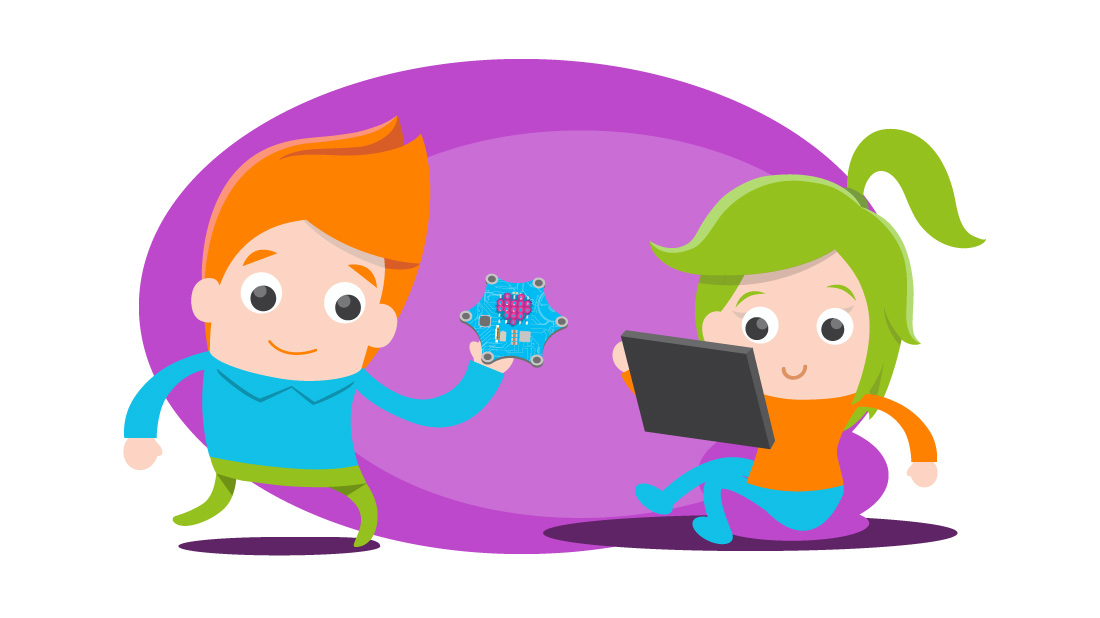Programming with the Calliope mini
Programming is considered the language of the future. A playful introduction to the world of coding can be implemented even with young children. There are now a variety of options for this introduction, both for school and family involvement.
For example, education-oriented visual programming languages such as Scratch or the Calliope microcontroller, which was developed for initial entry, offer quick access. Pocket-sized computers like the Raspberry Pi can be used with Scratch or the Python programming language. Arduino microcontroller boards are further steps into the world of programming. Regardless of which of these options is chosen, the most important thing is that the children have an "aha" effect and have fun as a result. This project idea shows how children can take their first steps into the world of programming using the Calliope mini microcontroller. To do this, they learn simple codes and the programming environment of the Caillope mini. In plenary, simple commands are explained in order to learn how the codes work. In teamwork, the children experiment with codes themselves. For example, a small melody or a short piece of music can be programmed as a learning outcome, which the children transfer to the Calliope and display.

In the project idea, the children are sensitized to the fact that many applications in everyday life are based on programmed codes and that our everyday life without programming has become unthinkable today. By learning the very first programming skills with the Calliope mini using a graphical programming language, they are introduced to contexts and backgrounds in programming technology in a playful way.
The children
learn simple command codes
learn programming principles such as loop (repetition) and variables
acquire initial knowledge about the Calliope mini and its programming environment
get to know the individual components of the Calliope mini
understand how they can control the Calliope using simple commands
The children
try out simple command codes themselves by varying text, image and sound commands
become familiar with the Calliope and the programming environment
enter simple command codes according to instructions, load them onto the Calliope and observe the programmed project.
The children
communicate in a team about the Calliope's components and programming environment
work out together how to enter the command codes
exchange information about the result display of the command codes on the Calliope
think together about further independent command codes and variations for text, image and sound output.
The children
think up further commands independently and on their own responsibility
approach problems in a solution-oriented and structured way and have a sense of achievement with the correct display of the command codes on the Calliope.
Project procedure
A short film and an introductory discussion on the topic of "Artificial Intelligence in everyday life" sensitize the children to the project topic. The children then familiarize themselves with the basic components of the Calliope and the programming environment. Step by step, they learn what a programming language is, how command codes are created and how they are passed on to the Calliope via an interface. Building on this, the children try their hand at a small "music project". They enter the codes in such a way that by stringing together notes, small melody sequences or a short piece of music is created.
Preparation
To set the mood, the children watch a short animated film (see additional information) on the topic of programmed machines in everyday life. Afterwards, the children are asked which concrete applications from everyday life they already know in which programmed machines or applications play a role (e.g., household, road traffic, medical technology).
To set the mood, the children watch a short animated film (see additional information) on the topic of programmed machines in everyday life. Afterwards, the children are asked which concrete applications from everyday life they already know in which programmed machines or applications play a role (e.g., household, road traffic, medical technology).
Securing results: Significance of programmed machines in everyday life
Social form: Plenary
Social form: Plenary
At the beginning of the phase, teams of two are formed within the project group. Each team is equipped with a computer and a Calliope mini. Using a Calliope mini as an example, the children will discuss together the construction with the associated components such as processor, poles, USB interface and cable, LED lights, speakers, sensors, etc. The children are then familiarized with the programming environment (editor) on the computer. They learn about the areas into which the editor is divided and the significance of the individual blocks of the editor for programming codes. To conclude this phase, the children learn how to download a project so that it can be displayed on the Calliope mini.
Securing results: Development of the Calliope structure/programming environment/display on the Calliope mini.
Social form: Plenary and teamwork
Social form: Plenary and teamwork
After the children have familiarized themselves with the Calliope and the editor, they learn the first programming steps. Depending on the children's previous knowledge, the programming projects can be very simple or more complex. If the very simple music project is chosen, the children try out how tones, given notes or melodies can be output via codes in preparation for phase 4. For this purpose, the blocks that have to be selected in the editor in order to create tones and melodies are discussed step by step in the plenary. Each team of two carries out the steps analogously on their computers and checks the output result on the Calliope mini.
Securing results: Entering simple codes for sound output
Social form: Plenary, teamwork
Social form: Plenary, teamwork
After the children have become familiar with entering their first codes, they work independently on their small music project and test the output on the Calliope mini. Projects that display several different texts or symbols on the Calliope or small melodies that they have coded themselves are popular. Changing the LED color displays is also very popular with the children.
Securing results: Own invented programming codes
Social form: Teamwork
Social form: Teamwork
Project summary
Programming with the Calliope mini introduces children to the world of programming in a very simple and playful way. The acquisition of initial programming skills promotes and expands general competencies that are necessary across all subjects. In this way, the children practice analytical thinking, can be creative and learn to solve problems.
Further information
Read more in the "Digital learning" dossier.
 The importance of developing skills such as creativity and critical thinking is often stressed.
Knowledge or competence?
The importance of developing skills such as creativity and critical thinking is often stressed.
Knowledge or competence?
 Teachtoday inspires and encourages cross-disciplinary and project-oriented knowledge transfer.
Learning by trial and error
Teachtoday inspires and encourages cross-disciplinary and project-oriented knowledge transfer.
Learning by trial and error
Big Data

In the digital world today, huge quantities of a wide variety of data are collected and evaluated automatically.
More information
Share this article!
Post the article with one click!
Share
